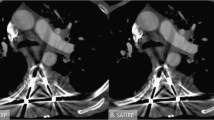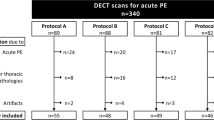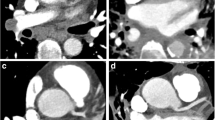Abstract
During a recent multi-center trial assessing gadolinium (Gd)-enhanced magnetic resonance angiography (MRA) for diagnosis of acute pulmonary embolism (PE), the Food and Drug Administration announced a risk of nephrogenic sclerosing fibrosis in patients with renal insufficiency who had received intravenous Gd-based MR contrast agents. Although no patients in this trial had renal insufficiency, in cautious response to this announcement, the trial protocol was changed from an intravenous administration of 0.2 mmol/Kg of a conventional Gd-based MR contrast agent to 0.1 mmol/Kg of gadobenate dimeglumine. The study described herein compares the signal quality of pulmonary MRA performed with double dose conventional agent to single dose gadobenate dimeglumine. This study is a retrospective analysis of data from a prospective, multicenter study in men and women ≥18 years with documented presence or absence of PE. The study was approved by the Institutional Review Board at all participating centers, and all patients provided written indication of informed consent. We performed both objective and subjective analysis of pulmonary artery image quality. Signal-to-noise ratio (SNR) and contrast-to-noise ratio (CNR) in the main pulmonary artery were assessed in single and double dose protocols and compared. SNR and CNR of the main PA were correlated with subjective quality assessment of main/lobar, segmental and subsegmental pulmonary arteries. Although there were individual outliers, both SNR (P = 0.01) and CNR (P = 0.008) were higher in all quartiles for examinations using gadobenate dimeglumine than with gadopentetate dimeglumine. Subjective quality of vascular signal intensity at each vessel order was significantly better for gadobenate dimeglumine (P < 0.0001), and correlated well with SNR and CNR at each order (<0.001). Because of agent high relaxivity, a single dose of gadobenate dimeglumine provides better pulmonary MRA signal quality than double dose of a conventional Gd-based MR contrast agent.



Similar content being viewed by others
References
Stein PD, Chenevert TL, Fowler SE, Goodman LR, Gottschalk A, Hales CA, Hull RD, Jablonski KA, Leeper KV, Naidich DP, Sak DJ, Sostman HD, Tapson VF, Weg JG, Woodard PK (2010) Gadolinium-enhanced magnetic resonance angiography for pulmonary embolism: a multicenter prospective study (PIOPED III). Annals Int Med 152(7):434–443
US Food and Drug Administration (2010) Information on gadolinium-containing contrast agents.http://www.fda.gov/Drugs/DrugSafety/PostmarketDrugSafetyInformationforPatientsandProviders/ucm142882.htm. Accessed 24 Sep 2010
Cowper SE (2009) International Center for Nephrogenic Fibrosing Dermopathy Research (ICNFDR). http://www.pathmax.com/dermweb/ last updated 25 Oct 2009
Prince MR, Arnoldus C, Frisoli JK (1996) Nephrotoxicity of high-dose gadolinium compared with iodinated contrast. J Magn Reson Imaging 6(1):162–166
Ledneva E, Karie S, Launay-Vacher V, Janus N, Deray G (2009) Renal safety of gadolinium-based contrast media in patients with chronic renal insufficiency. Radiology 250(3):618–628
Sam AD II, Morasch MD, Collins H, Song G, Chen R, Pereles FS (2003) Safety of gadolinium contrast angiography in patients with chronic renal insufficiency. J Vasc Surg 38(2):313–318
Stein PD, Woodard PK, Hull RD, Kayali F, Weg JG, Olson RE, Fowler SE (2003) Gadolinium-enhanced magnetic resonance angiography for detection of acute pulmonary embolism: an in-depth review. Chest 124(6):2324–2328
Hany TF, Schmidt M, Hilfiker PR, Steiner P, Bachmann U, Debatin JF (1998) Optimization of contrast dosage for gadolinium-enhanced 3D MRA of the pulmonary and renal arteries. Magn Reson Imaging 16(8):901–906
Goyen M, Debatin JF (2004) Gadopentetate dimeglumine-enhanced three-dimensional MR-angiography: dosing, safety, and efficacy. J Magn Reson Imaging 19(3):261–273
Stein PD, Gottschalk A, Sostman HD, Chenevert TL, Fowler SE, Goodman LR, Hales CA, Hull RD, Kanal E, Leeper KV Jr, Nadich DP, Sak DJ, Tapson VF, Wakefield TW, Weg JG, Woodard PK (2008) Methods of prospective investigation of pulmonary embolism diagnosis III (PIOPED III). Semin Nucl Med 38(6):462–470
Pintaskse J, Martirosian P, Graf H, Erb G, Lodemann KP, Claussen CD, Schick F (2006) Relaxivity of gadopentetate dimeglumine (Magnevist), gadobutrol (Gadovist), and gadobenate dimeglumine (MultiHance) in human blood plasma at 0.2, 1.5, and 3 tesla. Invest Radiol 41(3):213–221
Murphy BW, Carson PL, Ellis JH, Zhang YT, Hyde RJ, Chenevert TL (1993) SNR measures for MR imagers. Magn Reson Imaging 11:425–428
Gibbons JD, Chakraborti S (2005) Nonparametric statistical inference, 4th edn. Marcel Dekker, New York, p 314
Blum A, Bellou A, Guillemin F, Douek P, Laprévote-Heully MC, Wahl D (2005) Performance of magnetic resonance angiography in suspected acute pulmonary embolism. Thromb Haemost 93(3):503–511
Meaney JF, Weg JG, Chenevert TL, Stafford-Johnson D, Hamilton BH, Prince MR (1997) Diagnosis of pulmonary embolism with magnetic resonance angiography. N Engl J Med 336(20):1422–1427
De Haën C, Cabrini M, Akhnana L et al (1999) Gadobenate dimeglumine 0.5 mM solution for injection (MultiHance®): pharmaceutical formulation and physicochemical properties of a new magnetic resonance imaging contrast medium. J Comput Assisted Tomogr 23(Suppl 1):S161–S168
Aime S, Chiaussa M, Digilio G et al (1999) Contrast agents for magnetic resonance angiographic applications: 1H and 17O NMR relaxometric investigations on two gadolinium(III) DPTA-like chelates endowed with high binding affinity to human serum albumin. J Biol Inorg Chem 4:766–774
Blockley NP, Jiang L, Gardener AG, Ludman CN, Francis ST, Gowland PA (2008) Field strength dependence of R1 and R2* relaxivities of human whole blood to ProHance, Vasovist, and deoxyhemoglobin. Magn Reson Med 60(6):1313–1320
Krishnam MS, Tomasian A, Lohan DG, Tran L, Finn JP, Ruehm SG (2008) Low-dose, time-resolved, contrast-enhanced 3D MR angiography in cardiac and vascular diseases: correlation to high spatial resolution 3D contrast-enhanced MRA. Clin Radiol 63(7):744–755
Ersoy H, Goldhaber SZ, Cai T, Luu T, Rosebrook J, Mulkern R, Rybicki F (2007) Time-resolved MR angiography: a primary screening examination of patients with suspected pulmonary embolism and contraindications to administration of iodinated contrast material. AJR Am J Roentgenol 188(5):1246–1254
Krishnam MS, Tomasian A, Malik S, Desphande V, Laub G, Ruehm SG (2010) Image quality and diagnostic accuracy of unenhanced SSFP MR angiography compared with conventional contrast-enhanced MR angiography for the assessment of thoracic aortic diseases. Eur Radiol 20(6):1311–1320
Gerretsen SC, le Maire TF, Miller S, Thurnher SA, Herborn CU, Michaely HJ, Kramer h, Vanzulli A, Vymazal J, Wasser MN, Ballarati CE, Kirchin MA, Pirovano G, Leiner T (2010) Multicenter, double-blind, randomized intraindividual crossover comparison of gadobenate dimeglumine and gadopentetate dimeglumine for MR angiography of peripheral arteries. Radiology 255(3):988–1000
Prokop M, Schneider G, Vanzulli A, Goyen M, Ruehm SG, Douek P, Dapra M, Pirovano G, Kirchin MA, Spinazzi A (2005) Contrast-enhanced MR angiography of the renal arteries: blinded multicenter crossover comparison of gadobenate dimeglumine and gadopentetate dimeglumine. Radiology 234:399–408
Acknowledgments
This study was supported by Grants HL081593, HL177150, HL077149, HL077151, HL077154, HL081594, HL077358, HL077155, and HL077153 from the U.S. Department of Health and Human Services, Public Health Services, National Heart, Lung, and Blood Institute, Bethesda, Maryland.
Conflict of interest
Dr. Woodard received research support from GE Healthcare and Siemens Medical Systems. None of the other authors has paid speaking, grant support, equity or patents with any company that makes products relevant to this investigation.
Author information
Authors and Affiliations
Corresponding author
Additional information
ClinicalTrials.gov Identifier: NCT00241826.
Rights and permissions
About this article
Cite this article
Woodard, P.K., Chenevert, T.L., Dirk Sostman, H. et al. Signal quality of single dose gadobenate dimeglumine pulmonary MRA examinations exceeds quality of MRA performed with double dose gadopentetate dimeglumine. Int J Cardiovasc Imaging 28, 295–301 (2012). https://doi.org/10.1007/s10554-011-9821-6
Received:
Accepted:
Published:
Issue Date:
DOI: https://doi.org/10.1007/s10554-011-9821-6




